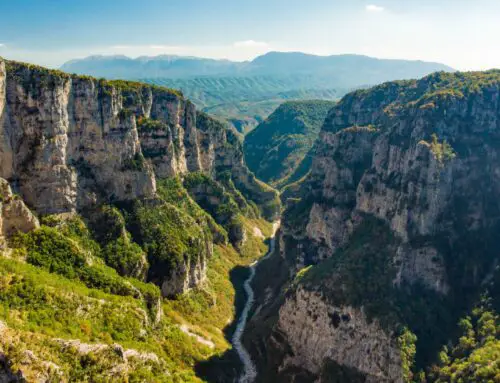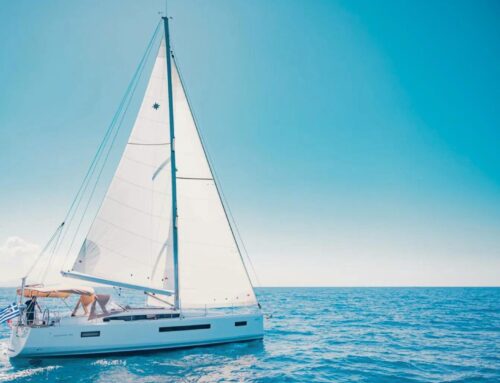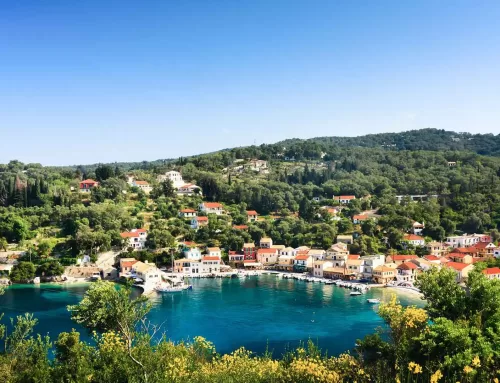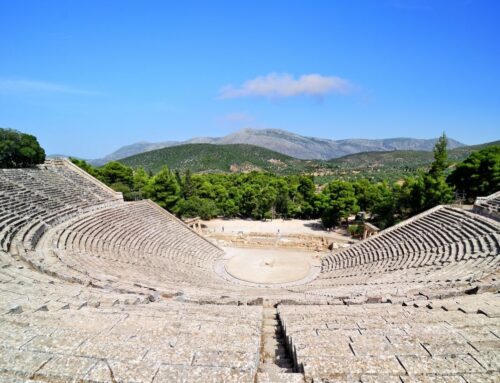
Scuba Diving in Greece: 6 Islands You Have To Explore Underwater
Scuba Diving in Greece: 6 Islands You Have To Explore Underwater



☞ Table of Contents:
Are you dreaming of scuba diving in Greece? Why wouldn’t you! Greece has a coastline of more than 16,000 meters, which puts it in the top 10 countries in the world. In addition, the protected waters of the Mediterranean make it an ideal spot for year-round diving and there is no shortage of interesting shipwrecks to explore.
Κostas Thoctarides, the famous Greek diver and maritime expert that has logged more than 14,000 hours of diving, including about 700 hundred shipwreck dives, has described the seabed of Greece as the richest in shipwrecks around the world. This includes the more than 1,500 registered wrecks of modern ships and aircraft as well as the countless other archaeological finds that are still being brought to light year after year.
Greece has more than 200 diving centers where you can take lessons whether you are a diving pro or a beginner.
The PADI course, which stands for Professional Association of Diving Instructors, is the standard certification that you need to have to dive.
Just like driving a car, it is best to be properly qualified before conquering the sea. There is no diving police and it is not illegal to dive without a certification, however, if you want to rent equipment from a diving school you will need to present your qualification. Considering there are over 200 diving schools around Greece, there is no reason to miss out on exploring the Mediterranean.
A basic PADI course that most people tend to start with is the “Open Water Diver” .
It takes 3-5 days and costs about 300 euro depending on the location.
What you will see when scuba diving in Greece
Between April and October is the ideal time for water temperature and you might also see some of the big stuff, like sharks, dolphins and sea turtles. In general, the big and scary sharks are very rare in the Aegean and Ionian Seas. It is much more likely to come across the plankton eating basking shark or the much smaller but very fast blue shark.
In addition to the shipwrecks, caves and tunnels, there is also the diverse seabed of the Mediterranean with its crystal clear waters teeming with marine species like cuttlefish, conger eels and octopus as well as nudibranchs, shrimp, crabs and seahorses.
Scuba diving in Crete Island
Crete is one of the largest islands in the Mediterranean and the largest in Greece.
It is one of the most well known Greek islands, famous for its stunning beaches, rich history and charming villages.
In Crete you can take part in all types of scuba diving excursions, whether you are after Wreck Diving, Wall Diving, Deep Diving or Night Diving
In the rich seabed of Crete you will find volcanic reefs and black corals as well as an abundance of marine life. El Greco Caves
A beautiful diving spot ideal for advanced divers that have previous experience in night diving that reaches a maximum depth of 26 meters.
Schinaria, Crete
Schinaria or Skinaria beach is located 30km south of Rethymno in the Libyan Sea. It is a beautiful beach that many travel to enjoy, protected by strong winds and currents due to the steep cliffs that surround it. The water is crystal clear and ideal for snorkeling and scuba diving with a deep and clear sea bottom that is full of fish. A small taverna that operates nearby is a favourite by visitors.
Daedalos, Crete
This diving spot is ideal both for new and advanced divers and can be explored to a depth of 27 meters for the latter. Here, you will have the opportunity to observe an abundance of aquatic life, from crabs and octopuses. Two beautiful reefs complete the scenery where groupers, morays, snappers, trevally and different types of sponges live.
Messerschmitt Wreck, Crete
Step into history with a unique dive on a German fighter plane from World War II. It’s upside down, but the cockpit, fuselage and wings are intact. You can see the machine guns and the wreck is frequented by groupers and eels.
Elephant’s Cave, Crete
The Elephant Cave is true to its name and probably one of the best dive spots in Crete according to the experts and famous around the world. Accidentally discovered by a local fisherman in 2000. White and red formations decorate the main cave that spans 160m long and is adorned with stalactites and stalagmites. The discovery of this cave is considered unique, bringing to light the fossils of a rare species of Elephant that lived in the area between 50,000 and 60,000 thousand years ago. Bones still remain attached to the caverns floor while the rest have since been moved for further study in Athens. Link to source


Scuba diving in Rhodes Island
Rhodes is often referred to as the Island of Knights. Visitors come to enjoy the Medieval City, listed as a UNESCO World Heritage Site, the ample sunshine and the stunning beaches.
The beautiful and calm clear waters that surround the island make an ideal destination for those looking to get their diving certification. More experienced divers, however, can also look forward to the dolphins, sting rays and turtles that frequent the waters of Rhodes, and with excellent visibility.
Cave of Seal, Rhodes
Αnother spectacular dive spot is the Cave of Seal, lodged between Anthony Quinn Bay and Ladiko. Particularly tricky to reach and requiring a boat, the cave is known for its beautiful deep waters.
Plimmiri, Rhodes
The dive at Plimmiri also called Giannoula K, is considered one of the best in the Aegean sea. Located in the southern tip of Rhodes island, this is the location of a sunken cargo ship measuring 110 long that perished in 1981.
What is interesting about this wreck is that it remains intact. At a maximum depth of 22 meters you can explore the upper decks of the ship as well as the interior including the engine room. Multiple dives might be required for this one.
Pentanissos Islet
This beautiful dive site is located in the south of Rhodes at the edge of the Lindos basin and is one of the deepest spots in the Mediterranean. The clear waters of the Aegean Sea really put on a show here, and there is much to be discovered within the caverns inside the wall.


Scuba diving in Santorini Island
Santorini is synonymous with romance and sunsets but it has also been gaining more popularity as a diving hotspot.
The waters of Santorini have an average visibility of more than 40m and the warm summer weather creates the perfect conditions for those that are just starting out.
Add to it the unique and varied underwater features of this volcanic island and you have a destination with endless possibilities for all sorts of diving, such as cave and wreck diving.
Nea Kameni
Νea Kameni is one of the top locations for diving enthusiasts in Santorini. That is the name for the crater around which modern Santorini is now formed. What is most exciting about Nea Kameni is the volcanic topography of the underwater. The wreck is found at quite a shallow depth, only 13 meters down, and can be explored inside and out.
The Caves, Santorini
Another volcanic spot with shallow waters that only reach 10 meters. This pathway of canyons and caverns is a spectacular spot for visitors to explore full of marine life waiting to be photographed.


Scuba diving in Naxos Island
Naxos has become one of the most popular destinations for families looking for relaxing summer holidays but there is so much more to it than just its beaches.
One of the largest islands of the Cyclades, Naxos has an unassuming island charm, with ancients ruins, mountains and local dishes that will make any visitor want to return again.
Arado 196 German Seaplane, Naxos
This diving spot is home to the German Seaplane Arado, which sank on September 17, 1943 close to Santorini and was moved to its current location by fishermen. It is a shallow dive, reaching only 11m, making it an ideal dive for beginners, night time diving and underwater photography.
The carcass of the plane sits upside down and is covered by marine vegetation but is still is relatively good shape with the wings mostly intact.
Marianna, Wreck
Do you have time to dive for another wreck? Why not!
This vessel was originally called “Niels Maersk” and was made in Dutch shipyards in 1961, before it moved to Greek ownership and was renamed Marianna.
In 1981, on its way from Piraeus to the Red Sea it crushed between Naxos and Paros taking with it the more than 41,000 bags of barley that it carried. The crew was rescued and moved to safety and Marianna was left half sinking until a decision could be made about what was to be done with it. In the end, the part of the ship that still floated above sea level was blown up and attempts were made to remove as much of the equipment and precious metal from the ship to other locations. The funnel of the ship can still be seen on the rocks close to where the wreck is now located.
This is a beautiful diving spot with corals and sponges covering big parts of the remaining ship at a maximum depth of 25 meters. It is best suited for advanced divers.
The Dome, Naxos
Another stunning location in an uninhabited islet very close to Paros and Antiparos, neighboring islands from Naxos and under half an hour away on boat. The dome that is 20m high is the highlight of this dive full of beautiful stalactites and marine life.
This large cavern dive sports a good variety of marine life, but the marquee experience is an air-filled dome that seems to be lit with an ethereal blue light. Small schools of cardinal fish as well as scorpion-fish can often be seen here.


Scuba diving in Mykonos Island
Mykonos is undoubtedly one of the most visited Greek islands, welcoming tourists from all around the world that seek a cosmopolitan and luxurious spot to enjoy their summer holidays.
The Ibiza of Greece, Mykonos has in the last few decades become a top party destination, with DJ’s from around the world attracting crowds that prefer to sleep all day and party all night.
Yet, Mykonos also remains one of the most traditional and well-preserved islands of the Cyclades in terms of its architecture and island aesthetic.
Anna II Wreck
Another cargo ship built in Holland that made its final voyage in 1995 and has since been attracting transformed into an artificial reef attracting colonies of sponges and marine life.
The wreck is in very good condition and can also be explored from inside in certain parts.
Prasonisia, Mykonos
Prasonisia is a small island off the coast of Mykonos that is easily accessible by boat and suitable for all levels of ranging in depth from 5 to 18m. What most people don’t know is that scuba diving was illegal in Greece until very recently when restrictions were lifted due to the fear of looting or archaeological treasures. Nowhere is this more evident than in Prasonisia, where ancient amphora lie in between the fleets of Mediterranean barracuda and other marine life.
Dragonisi Island Caverns, Mykonos
Another top spot according to diving experts and locals that is especially interesting for any underwater photographers. The strong light makes sure there is great visibility and allows the stunning rock formations to come to life. If you are lucky you might also get to hang out with a monk seal that are often lingering around the area.
Scuba diving in Zakynthos Island
You might know of Zakynthos as Zante or maybe the home of one of the most highly rated and easily recognizable beaches in the world, the Shipwreck or Navagio.
This stunning beach adorns the front pages of many a travel brochures and has been a top spot for international visitors in the last few decades.
But Zakynthos is also known as the nesting spot for the endangered species of Caretta-caretta turtles. Every year more than 1,300 nests are created on the shores of Laganas Bay which is protected by legislation as one of the most important shelters of this sea turtle.
Marathonisi, Zante
Just like all of the islands in the Ionian Sea, Zakynthos offers clear emerald waters that are a divers dream. The dive in Marathonisi is an easy site for all levels that is mostly around shallow and protected waters around the area of “Turtle Island” which is another name for Marathonisi.
You will have the opportunity to swim in and around rock formations and a stunning limestone reef where large octopuses like to spend their time. It is not uncommon for Monachus Monachus seals to also be spotted around this area.
The Arc de Triumph Cave
This is a cavern dive site and one of the most popular ones in the island due to show stopping huge arch that is formed by the rocks. The entrance to the arch is found at a depth of about 8m which gradually deepens around the limestone reef that is full of life. Octopuses, moray eels, groupers and lobsters can be found along the reef while the deeper you get you will come across larger fish like the bluefish tuna. This is an ideal spot for more advanced divers with a diverse scenery and options for all experience levels.


Of course the islands above cover only but a few of the thousand stunning diving locations that are scattered around Greece. Every spot is unique and offers visitors an opportunity to witness a piece of history, both modern and ancient.
While diving in the Mediterranean is often considered minor compared to other tropical destinations, it can definitely surprise you. We hope you get to experience it soon.
*Disclaimer: This page might include affiliate links. If you decide to book something through one of them, I might get a little bonus, but it won't cost you anything extra.*





























